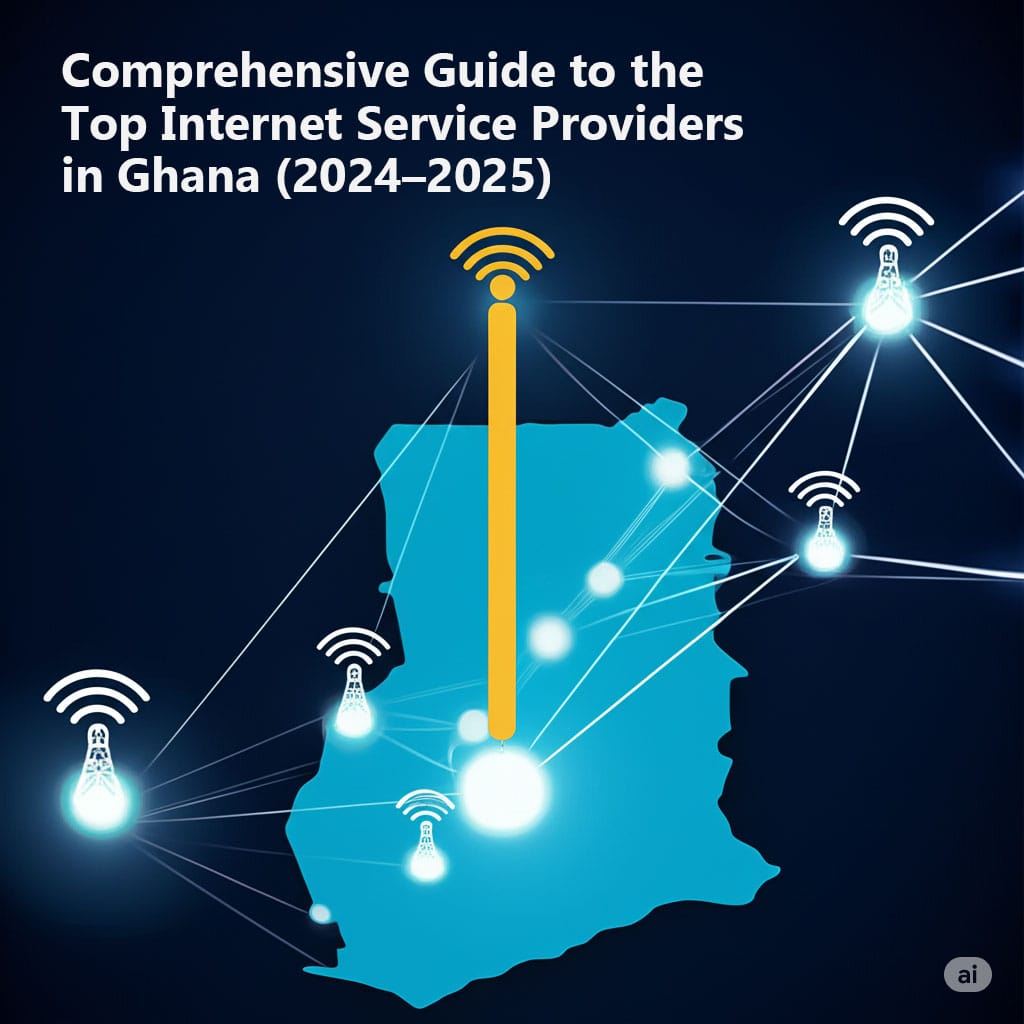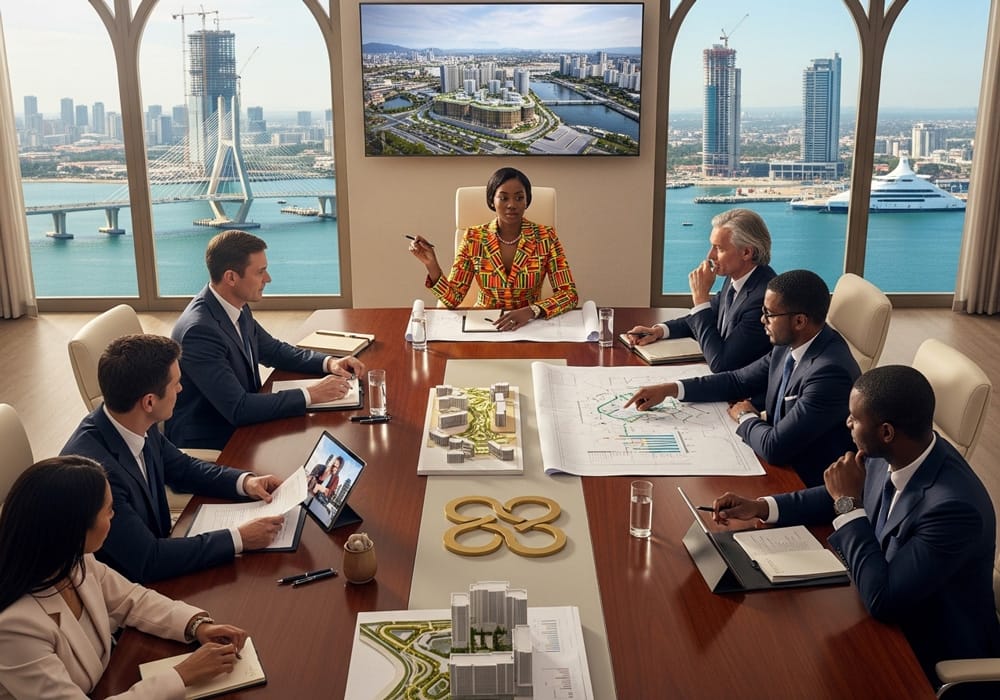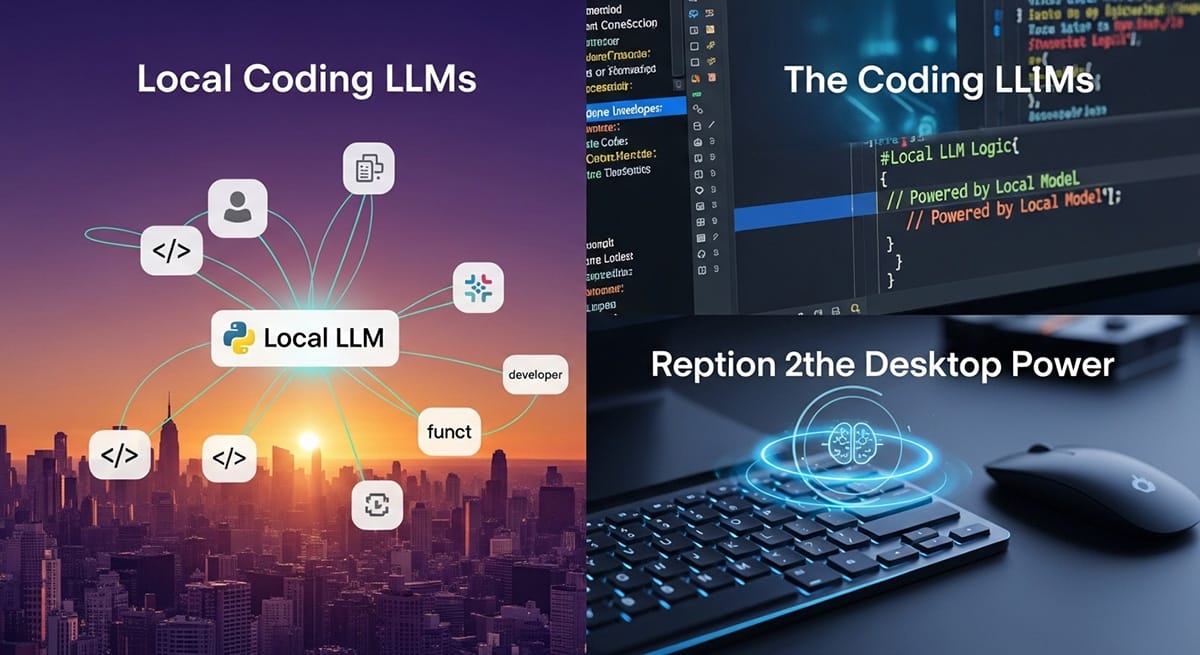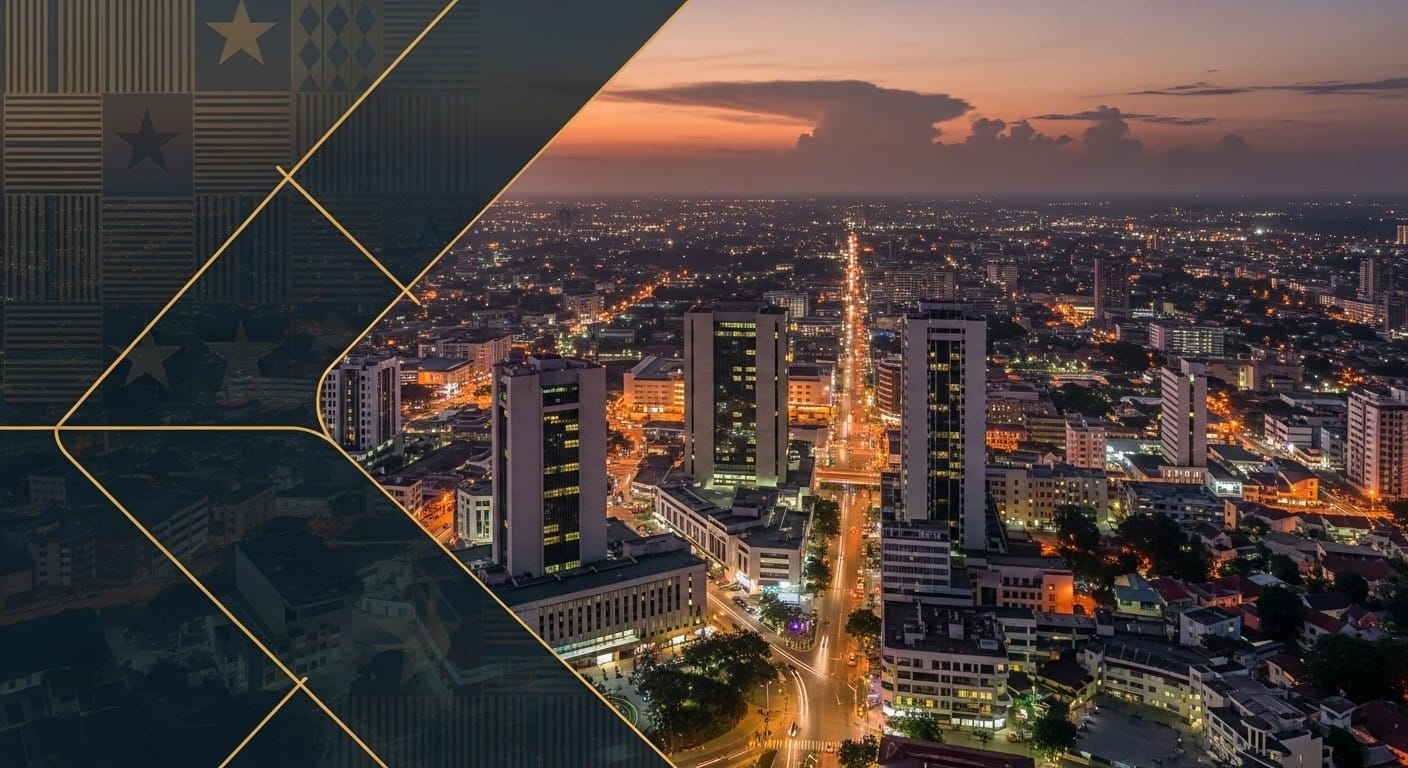Ghana’s digital landscape is evolving rapidly. With internet penetration nearing 70% and fixed broadband still nascent, the quest for fast, reliable, and affordable connectivity has become paramount for residents, businesses, policy makers, and industry stakeholders alike. This article dives deep into Ghana’s Internet service providers Ghana provider (ISP) ecosystem, unpacking market share, technologies, pricing, performance, challenges, solutions, and emerging trends. Whether you’re a household seeking the best home fiber plan, a company hunting enterprise-grade links, an NGO pushing digital inclusion, or a telco professional benchmarking competition, this guide will equip you with the data-driven insights you need.
1. Market Landscape and Key Players
1.1 Market Share and Competitive Dynamics
- MTN Ghana (Scancom Plc): Dominant leader with approximately 80% of Ghana’s internet subscribers. As the incumbent mobile operator, MTN commands extensive Mobile Broadband and a growing fiber network.
- Telecel Ghana (formerly Vodafone Ghana): Holding around 16% of the market, Telecel maintains a strong position in urban areas through competitive 4G bundles and selective fiber deployments.
- Glo Ghana (Ghana Telecommunications Company Ltd.): With roughly 3–5% share, Glo offers nationwide 4G/LTE service, often at lower price points but with somewhat slower speeds.
- Airtel Ghana (AirtelTigo): Now consolidated to a smaller customer base (~3%), Airtel focuses on niche packages and seasonal promotions to retain subscribers.
- Regional and Niche ISPs: Several local players (Tsunami Broadband, BusyInternet, Simba Fiber, Telenet Ghana, 3D Wireless Plus) specialize in fixed broadband—largely fiber-to-the-home (FTTH) or fixed-wireless in Accra, Kumasi, Tema, and Takoradi. These providers cater to residential and small- to medium-businesses with dedicated service-level commitments.
- Satellite Entrants: In 2024, Starlink gained regulatory approval to serve urban and rural areas. Traditional VSAT providers (YahClick, Eutelsat) continue to serve enterprises needing resilient, remote connectivity.
Takeaway: Ghana’s ISP market is highly concentrated at the top—mobile operators control the bulk of subscribers. Fixed broadband penetration remains low (<1% of population), leaving ample white space for regional fiber players and emerging satellite solutions.
2. Internet Technologies and Coverage
Ghanaian ISPs deploy a mix of modern connectivity solutions. Understanding each technology’s strengths and limitations is critical for selecting the right service.
2.1 Fiber-Optic Broadband (FTTH/FTTB)
- Availability: Concentrated in major metropolitan areas—Accra, Kumasi, Takoradi, Tema, and parts of Tamale.
- Providers: MTN Home (consumer), Telecel Home, Tsunami Broadband, BusyInternet, Simba Fiber, Telenet Ghana, LinMBiz, and regional cable operators.
- Speeds & Plans: Typically tiered by speed (10 Mbps → 1 Gbps) with unlimited data. Residential packages often start around 10–15 Mbps for ~GHC300–400/month, rising to 30–50 Mbps for GHC700–1,000. Business-grade fiber is priced higher, with 20–100 Mbps packages ranging from GHC1,000 to GHC5,000+ monthly.
- Advantages: Low latency (<20 ms), consistent speeds, true unlimited usage, symmetrical upload/download.
- Limitations: High upfront installation fees (~GHC200–500), infrastructure roll-out constraints in peri-urban or rural districts, occasional last-mile disruptions.
2.2 Mobile Broadband (4G LTE)
- Coverage: Nationwide coverage exceeding 90% population reach for MTN, ~80% for Telecel, ~75% for Glo, and ~60% for Airtel.
- Usage Models:
- Smartphone Data Bundles: Prepaid/Pay-as-you-go (e.g., 1 GB for GHC5–10, 5 GB for GHC20–30) and postpaid plans with bundled allowances.
- Home Router (MiFi) Bundles: 4G Wi-Fi routers with monthly data allotments (e.g., 30 GB → 100 GB for GHC100–200).
- Corporate SIM-Only Plans: Bulk data allocations for machine-to-machine (M2M) or IoT use.
- Performance: Average nationwide speeds (SpeedChecker Feb 2024):
- MTN 4G: ~15.5 Mbps down / 10.4 Mbps up | ~47 ms latency
- Telecel 4G: ~9.3 Mbps down / 9.2 Mbps up | ~46 ms latency
- Airtel 4G: ~8.9 Mbps down / 3.0 Mbps up | ~128 ms latency
- Glo 4G: ~6–8 Mbps down / ~4–6 Mbps up | ~50–60 ms latency
- Advantages: Rapidly scalable, no fixed infrastructure needed, suitable for rural/remote areas.
- Limitations: Data-capped usage, variable speeds depending on network congestion, higher latency than fiber.
2.3 Fixed Wireless Access (FWA)
- Providers: 3D Wireless Plus, BusyInternet (WiMAX legacy), Surfline (phased out), and select MTN/Telecel/LTE-router deals.
- Coverage: Urban hotspots, business districts, or schools/hospitals under Smart Communities.
- Performance: Speeds range 10–50 Mbps; reliability can be uneven in bad weather. Designed as an alternative where fiber is unavailable.
2.4 Satellite Broadband
- New Entrant—Starlink:
- License: Granted in early 2024, anticipating consumer service rollout by mid-2024.
- Projected Speeds: 50–200 Mbps down / 10–20 Mbps up, low-latency (~30 ms).
- Pricing Estimate: Global Starlink base plans run $110/mo (≈GHC1,500) plus GHC1,000 equipment cost—localized pricing expected to be slightly higher due to import duties.
- Traditional VSAT: Eutelsat’s YahClick, Avanti Ka-band, etc., used by enterprises, NGOs, government outposts.
- Advantages: Covers entire country, bypasses terrestrial backhaul constraints, resilient to terrestrial disruptions.
- Limitations: High monthly fees, equipment investments, susceptible to heavy rain fade.
2.5 5G Readiness
- Initiative: Ghana’s Next Generation Infrastructure Company (NGIC) launched in 2023 to build out neutral-host 4G/5G infrastructure nationwide.
- Current Status (Q2 2025):
- ~350 NGIC towers under build-out in Accra, Kumasi, and regional hubs, ~50 equipped with 5G-ready radios.
- Pilot 5G trials expected mid-2025 in central Accra. Major telcos (MTN, Telecel) preparing commercial 5G handsets/plans.
- Expectations:
- Consumer 5G service likely toward late 2025.
- Enterprise 5G private networks (smart factories, campuses) already under feasibility studies.
3. Residential vs. Business Internet Services
Ghana’s internet users fall broadly into two categories—households seeking affordability and flexibility, and enterprises requiring performance guarantees and support.
3.1 Residential Internet
- Mobile Data Dominance: Roughly 60–70% of households rely primarily on 4G smartphone data for everyday needs (social media, streaming, mobile banking). Seasonal promotions and scratch-card bundles are extremely popular.
- Home Fiber Uptake: In affluent neighborhoods of Accra and Kumasi, FTTH adoption has surged. Key considerations for residential customers:
- Speed Requirements: 10–50 Mbps for typical video streaming, online gaming, or remote schooling.
- Budget Constraints: Typical consumer fiber plans range GHC300–800/month. Bundled services (cable TV, VoIP) may be added.
- Installation Fees & Equipment: One-time fees (GHC200–500) for router/CPE installation. Some providers waive fees during promos.
- Customer Support: 24×7 helplines, SMS & app-based troubleshooting, occasional on-site technician visits.
- Residential Pain Points:
- Affordability: Even “affordable” fiber plans represent ~5–10% of median urban incomes.
- Last-Mile Outages: Unexpected fiber cuts from roadworks, theft, or weather can disrupt service for days.
- Data Caps on Mobile: Heavy data users complain of expensive top-ups when bundles run out.
3.2 Business & Enterprise Internet
- Dedicated Links & SLAs: Businesses demand static IP addresses, priority routing, guaranteed uptimes (≥99.5%), and rapid fault resolution (4–8 hour SLAs).
- Speed & Scalability: Small businesses often start with 10–20 Mbps fiber (GHC750–1,000/month), scaling to 100–500 Mbps (GHC3,000–15,000). Large enterprises may deploy multiple Gbps links, MPLS/VPN, or private backbone paths.
- Value-Added Services: Local ISPs bundle cloud hosting, backup solutions, firewall management, and VoIP. Some telcos provide data center co-location.
- Redundancy & Resilience: Many companies use dual-homed connectivity—fiber primary, LTE backup—using SD-WAN or failover routers to ensure business continuity.
- Regulatory Compliance: Sectors like banking, insurance, healthcare require data encryption, local data storage, and cybersecurity certifications. ISPs often assist with compliance (ISO 27001, PCI-DSS).
4. Pricing Comparison and Data Packages
Below is a representative sample of consumer and business internet packages from leading ISPs. Prices are approximate (2024–2025) and exclude VAT (~12.5%) and service taxes.
| ISP | Plan Category | Speed | Data Allowance | Monthly Fee (GHC) | Installation | Type |
|---|---|---|---|---|---|---|
| MTN Ghana | Home Fiber | 10 Mbps | Unlimited | 350 | 300 | FTTH (Consumer) |
| Home Fiber | 20 Mbps | Unlimited | 550 | 300 | FTTH (Consumer) | |
| Home Fiber | 50 Mbps | Unlimited | 1,050 | 300 | FTTH (Consumer) | |
| Business Fiber | 10 Mbps | Unlimited | 754 | 500 | FTTH (Enterprise) | |
| Business Fiber | 30 Mbps | Unlimited | 1,972 | 500 | FTTH (Enterprise) | |
| Telecel Ghana | Home Fiber | 10 Mbps | Unlimited | 329 | 250 | FTTH (Consumer) |
| Home Fiber | 25 Mbps | Unlimited | 729 | 250 | FTTH (Consumer) | |
| Business Fiber | 20 Mbps | Unlimited | 1,104 | 500 | FTTH (Enterprise) | |
| Business Fiber | 45 Mbps | Unlimited | 4,059 | 500 | FTTH (Enterprise) | |
| Simba Fiber | Home Fiber | 15 Mbps | Unlimited | 400 | 200 | FTTH (Consumer) |
| Home Fiber | 25 Mbps | Unlimited | 540 | 200 | FTTH (Consumer) | |
| Home Fiber | 35 Mbps | Unlimited | 740 | 200 | FTTH (Consumer) | |
| Business Fiber | 100 Mbps | Unlimited | 1,500 | 250 | FTTH (Enterprise) | |
| Telenet Ghana | Home Fiber | 10 Mbps | Unlimited | 329 | 250 | FTTH (Consumer) |
| Home Fiber | 15 Mbps | Unlimited | 429 | 250 | FTTH (Consumer) | |
| Home Fiber | 25 Mbps | Unlimited | 729 | 250 | FTTH (Consumer) | |
| Business Fiber | 50 Mbps | Unlimited | 2,750 | 500 | FTTH (Enterprise) | |
| MTN Ghana | 4G Mobile Data | N/A | 10 GB (Bundle) | 30 | N/A | Prepaid (MiFi/Smartphone) |
| 4G Mobile Data | N/A | 50 GB (Bundle) | 100 | N/A | Prepaid (MiFi/Smartphone) | |
| Telecel Ghana | 4G Mobile Data | N/A | 10 GB (Bundle) | 25 | N/A | Prepaid (MiFi/Smartphone) |
| 4G Mobile Data | N/A | 50 GB (Bundle) | 90 | N/A | Prepaid (MiFi/Smartphone) | |
| Airtel Ghana | 4G Mobile Data | N/A | 10 GB (Bundle) | 28 | N/A | Prepaid (MiFi/Smartphone) |
| 4G Mobile Data | N/A | 50 GB (Bundle) | 95 | N/A | Prepaid (MiFi/Smartphone) | |
| Starlink | LEO Satellite | 50–200 Mbps | 150 GB (Cap) | 1,500–1,800 (est.) | 2,500 (est.) | Satellite (Consumer) |
| LEO Satellite | 50–200 Mbps | 500 GB (Cap) | 3,500–4,000 (est.) | 2,500 (est.) | Satellite (Enterprise) |
Table: Representative Broadband and Mobile Data Plans in Ghana (2024–2025).
- “N/A” indicates that speed is not a fixed metric (mobile data is shared); “GB” denotes gigabytes.
- “Unlimited” for fiber means no hard data caps but subject to fair-usage policies.
- Satellite Broadband is preliminary and subject to local licensing.
5. Network Performance and Quality of Service
5.1 Speed & Latency Insights
- Fixed Broadband (Fiber): Urban fiber customers regularly record 50–500 Mbps download speeds. Latency is typically 10–20 ms domestically, rising to 80–120 ms for international traffic (e.g., to Europe or North America).
- 4G LTE: Average national speeds:
- MTN: 15.5 Mbps (down) / 10.4 Mbps (up) | ~47 ms latency
- Telecel: 9.3 Mbps / 9.2 Mbps | ~46 ms latency
- Airtel: 8.9 Mbps / 3.0 Mbps | ~128 ms latency
- Glo: 6–8 Mbps / 4–6 Mbps | ~50–60 ms latency
- Fixed Wireless (WiMAX/Wi-Fi): Urban hotspots can yield 10–50 Mbps down, but rain fade and line-of-sight issues cause variable reliability.
- Satellite (Starlink): Predicted 50–200 Mbps down / 10–20 Mbps up | ~30 ms latency—on par with fiber, but depends on clear skies.
5.2 Reliability & Uptime
- Undersea Cable Vulnerability: Through 2024, multiple cuts (ACE, WACS, MainOne) caused nationwide outages. Network redundancy remains under-optimized; many operators rely primarily on two or three cables.
- Power & Infrastructure: Frequent power outages, especially outside Accra, necessitate diesel or solar backup for base stations, routers, and last-mile equipment. Urban fiber networks are relatively stable; rural fixed-wireless can see 2–5 hours downtime monthly due to equipment faults.
- Customer Support: Larger telcos (MTN, Telecel) maintain 24×7 call centers, mobile technicians, and digital portals. Regional ISPs often guarantee on-site response within 4–8 hours for businesses. Historically, smaller ISPs face resource constraints during peak outage events.
6. Challenges and Pain Points
A nuanced understanding of Ghana’s ISP environment must factor in these persistent and systemic challenges:
6.1 Limited Competition and Market Concentration
- MTN’s Dominance: With nearly 80% of total internet subscribers, smaller players struggle to compete on pricing and coverage, stifling innovation. Retail ISPs struggle to secure backhaul capacity at competitive rates.
- Barriers to Entry: High spectrum licensing costs, bureaucratic delays in obtaining permits, and capital-intensive fiber roll-out hinder new entrants.
6.2 Affordability and Data Costs
- High Relative Costs: 1 GB of mobile data often costs ~GHC5–6 ($0.50–$0.60), approaching daily minimum wage. Monthly “affordable” fiber plans at GHC300–400 still price out large segments of lower-income households.
- Tax Burden: Excise duties on telecom equipment, VAT on data bundles, and SIM registration levies cumulatively inflate end-user prices by 15–25%.
6.3 Infrastructure Gaps and Rural Divide
- Low Fixed Broadband Penetration (<1%): Outside major cities, fiber is rare; rural communities rely on slower 3G/4G or satellite. Nearly 60% of districts lack any form of fixed-line network.
- Digital Literacy & Local Content: Many rural users lack digital skills and native-language content, limiting Internet’s socio-economic impact.
6.4 Network Resilience & Redundancy
- Undersea Cable Dependency: With only three major cables serving Ghana (ACE, WACS, MainOne), a single fault can paralyze national connectivity for days.
- Power Instability: Rolling blackouts still occur outside Accra, affecting both mobile base stations and local area networks. Diesel backup is expensive; solar microgrids are still emerging.
6.5 Regulatory and Policy Hurdles
- Spectrum Allotment: 5G auctions delayed repeatedly. So far, spectrum has been allocated to NGIC rather than directly to operators, slowing consumer 5G Adoption.
- Complex Licensing: Fiber rights-of-way, tower permits, environmental clearances—all involve multiple agencies, causing project delays of 6–12 months.
6.6 Customer Experience Shortfalls
- Billing Disputes & Hidden Charges: Occasional surprise fees on mobile data rollover or fiber provisioning.
- Patchy Customer Support: Some smaller ISPs lack scalable 24×7 support, leading to customer frustration when outages occur.
7. Strategic Responses and Government Initiatives
Recognizing these gaps, Ghana’s government and private sector have undertaken multiple initiatives to advance connectivity, affordability, and resilience.
7.1 e-Transform and Smart Communities Projects
- e-Transform (World Bank–Funded): By mid-2024, delivered 1 Gbps fiber connectivity to 951 public institutions (schools, hospitals, government offices), reducing digital divides in e-government and health services.
- Smart Communities (GIFEC): Deployed Wi-Fi hotspots, telecommunications towers, and solar mini-grids in over 1,000 rural communities since 2022. Provides free or subsidized access points in key public spaces, aiming to reach 1,500 communities by year-end 2025.
7.2 Next Generation Infrastructure Company (NGIC)
- Neutral-Host Model: NGIC constructs and maintains cell towers with 4G/5G capabilities on behalf of all operators, charging lease fees rather than operators duplicating infrastructure.
- Rollout Progress (Early 2025):
- ~350 towers under construction in major urban and peri-urban constituencies.
- 50 sites equipped with 5G-ready radios; pilot 5G tests scheduled Q3 2025.
- Projected to compress network coverage gaps from 10% (4G) to <2% by late 2025.
7.3 Policy and Tax Reforms
- Import Duty Reduction on Devices: The Ministry of Trade & Industry proposed scrapping import duties on certain smartphones (priced below $200), boosting affordability for end-users.
- SIM Registration and Data Protection: New regulations mandate stringent SIM registration to curb fraud, which temporarily depressed subscriber growth but is improving data integrity and consumer trust.
- Digital Ghana Agenda (2023–2025): Focused on expanding e-government services (e.g., online tax filing, digital IDs), making connectivity more necessary.
7.4 Private Sector Investments
- MTN Capex Commitments: Committed over $1 billion to expand fiber and 4G/LTE networks through 2026, including cross-border fiber in West Africa.
- Submarine Cable Projects:
- Africa-1 (West Africa Cable System) launched Q4 2024, increasing Ghana’s international capacity by 60%.
- SEA-ME-WE 6 (expected 2025) will further diversify transit routes.
- Renewable Power Integration: Operators like MTN and Telecel are piloting solar-plus-battery microgrids to power rural base stations, reducing reliance on diesel.
8. Emerging Trends and Future Outlook
Several pivotal trends will shape Ghana’s ISP landscape in the next 2–3 years:
8.1 5G Adoption and Private Networks
- 5G Deployment: Full consumer 5G service is anticipated by Q4 2025 in Accra and Kumasi, with commercial devices available by then. Early adopters will be data-intensive enterprises (healthcare, manufacturing) seeking ultra-low latency and massive IoT support.
- Private 5G Networks: Organizations (universities, mines, large factories) are evaluating campus networks for logistics, real-time analytics, and industrial automation.
8.2 Satellite Broadband Expansion
- Starlink’s Impact: As a first mover in LEO satellite, Starlink could revolutionize rural and peri-urban connectivity by offering low-latency, high-speed internet where terrestrial fiber/4G are lacking. NGIC–Starlink partnerships may yield hybrid service bundles.
- Local VSAT Evolution: Next-gen high-throughput satellites (HTS) from players like Eutelsat and Avanti will compete with LEO offerings, gradually driving down costs across all classes of satellite internet.
8.3 Infrastructure Sharing & Neutral Host Growth
- TowerCo Model Gains Traction: Companies such as American Tower Ghana and Eaton Infratech are leasing passive infrastructure (towers, shelters) to multiple operators, reducing capital duplication.
- Fiber-to-The-Tower Initiatives: Open-access fiber backbones are emerging, enabling smaller ISPs to lease dark fiber instead of building last-mile links.
8.4 Digital Inclusion and Content Localization
- Language & Education Platforms: Local-language edutech and telemedicine portals are growing, spurring demand for reliable connectivity.
- Youth Digital Literacy: Programs targeting digital skills in secondary schools have increased internet usage by under-18 populations, essential for future workforce development.
- Mobile Money Integration: With nearly 80% of adults using mobile money, fintech services are a major driver of data usage. Bundles that prioritize fintech apps enjoy higher uptake.
8.5 Green and Resilient Networks
- Solar Backup & Microgrids: Telecom operators are installing solar-battery systems at remote sites, anticipating 60% tower solarization by 2026.
- Undersea Cable Redundancy: New cables (Africa-1, SEA-ME-WE 6) will reduce single-point failures. Plans to integrate microwave and satellite backhaul for critical nodes are underway.
8.6 Regulatory Shifts and Regional Integration
- Quality-of-Service Enforcement: NCA’s new QoS regulations (2024) mandate minimum 4G speeds (≥10 Mbps urban, ≥5 Mbps rural) and mobile coverage obligations, pushing operators to expand infrastructure.
- AfCFTA & Roaming: The African Continental Free Trade Agreement (AfCFTA) digital provisions aim to lower intra-continental data roaming costs. Ghana is negotiating regional “West Africa Roaming Zone” agreements to allow seamless travel connectivity with Nigeria, Ivory Coast, and Burkina Faso.
9. Decision-Making Guide: How to Choose Your ISP
Selecting the right internet service depends on your specific needs—budget, location, speed requirements, and intended use. Below is a decision framework:
- Assess Your Use Case:
- Light User (browsing, social media) → Consider basic mobile data bundles (1–5 GB/mo).
- Streaming/Gaming Family → Look at 20–50 Mbps fiber plans (GHC550–1,050).
- Small Office/SME → 10–20 Mbps business fiber (GHC750–1,100) with SLA.
- Large Enterprise/Datacenter → 100 Mbps–1 Gbps leased fiber (GHC3,000–15,000), redundant routing.
- Rural or Underserved Area → Evaluate Starlink (≥50 Mbps satellite) or FWA options.
- Check Coverage:
- Urban Districts: Fiber providers (MTN, Telecel, Simba, Telenet).
- Peri-Urban/Township: 4G LTE from MTN/Telecel/Glo or fixed wireless (3D Wireless Plus).
- Deep Rural: Satellite (Starlink), community Wi-Fi hotspots (Smart Communities), or regional fiber backhaul if available.
- Compare Pricing & Bundles:
- Seek promotional offers: zero-install deals, discounted first-month fees.
- Bundle mobile data and voice if you already use the same operator (e.g., MTN multiplay packages).
- Consider fair-usage policies: “unlimited” fiber is subject to throttling beyond 1 TB–2 TB in some cases.
- Evaluate Performance & Reliability:
- Speed Tests & Ping: Review local user reviews or independent tests (e.g., SpeedChecker) for neighborhood-level performance.
- SLAs & Support: Businesses should demand ≥99.5% uptime guarantees and 4–8 hour mean time to repair (MTTR).
- Backup Options: Dual-homed links (e.g., fiber + 4G backup) can save critical downtime.
- Assess Customer Experience:
- Response Times: Look for providers with 24×7 help lines and dedicated account managers (for businesses).
- Transparency: Avoid ISPs with frequent billing surprises. Read the fine print on “installation,” “equipment,” and “early termination” fees.
10. Recommendations and Outlook
Based on current trajectories and anticipated developments, stakeholders should consider the following:
For Residential Consumers
- Adopt Fiber Early Where Possible: If living in Accra, Kumasi or similar cities, fiber delivers the best speed-to-price ratio. Shop around for regional ISPs (Simba Fiber, Telenet) that may undercut larger telcos.
- Bundle Mobile & Home Services: If you’re already a loyal mobile customer (e.g., MTN or Telecel), bundling may yield discounted data bonuses or waived installation fees.
- Leverage Government-Funded Wi-Fi: Check Smart Communities hotspot locations for free or subsidized access if your area is covered.
For Small & Medium Businesses
- Prioritize SLAs Over Cheapest Rates: Better to pay a premium for guaranteed uptime (4–8 hr MTTR) than suffer extended outages.
- Implement Redundant Backhaul: Combine primary fiber with LTE or fixed wireless failover. Consider satellite backup if in a flood- or cable-cut-prone zone.
- Plan for 5G Transition: In late 2025, consider piloting 5G connectivity for IoT or real-time operations (e.g., video conferencing, cloud-based apps).
For Large Enterprises & NGOs
- Engage in Early 5G Trials: Private 5G campus networks could revolutionize warehousing, manufacturing, and large-campus deployments.
- Leverage Bulk Satellite Agreements: If operating in remote areas (mines, oilfields, mining camps), lock in enterprise satellite packages with volume discounts.
- Participate in Shared Infrastructure: Work with NGIC and TowerCo operators to lease infrastructure rather than build redundant networks.
For Government & Policymakers
- Accelerate 5G Spectrum Auctions: Clear regulatory uncertainty to spur private-sector 5G deployments—encourage co-investment with NGIC.
- Increase Subsidies & Tax Incentives: Further reduce import duties on smartphones, routers, and VSAT gear to boost affordability.
- Expand Digital Literacy Programs: Deepen rural digital skills training, focusing on local-language content and e-learning platforms.
- Enforce QoS Regulations: Ensure operators meet minimum speed and coverage targets, penalize underperformers, and promote infrastructure sharing to avoid duplication.
For Industry and Civil Society
- Promote Community Networks: Encourage local cooperatives to build mesh-based Wi-Fi in rural clusters, leveraging unused TV-spectrum (TV White Space) where legal.
- Monitor Cost-Per-GB Trends: Advocate for price-benchmarking dashboards to foster transparency, comparing cost-per-gigabyte across operators monthly.
- Foster Local Content & Platforms: Develop apps and platforms (telemedicine, e-commerce, e-governance) that rely on low-bandwidth modes to drive further demand.
11. Conclusion
Ghana’s ISP industry stands at a transformative juncture. While MTN’s dominance continues, a confluence of government initiatives, private investments, and new technologies (5G, satellite LEO) promises to reshape the competitive landscape. Fixed broadband remains a premium service in major cities, but mobile data and emerging satellite solutions ensure that the country’s rural communities will not be left behind.
Affordability, infrastructure gaps, and regulatory bottlenecks persist as lingering challenges. Yet ongoing programs like e-Transform, Smart Communities, and NGIC’s neutral-host model are systematically addressing these issues. The next 12–18 months will be critical: the first consumer 5G rollouts, Starlink’s mainstream adoption, and renewed undersea cable capacity will likely drive faster speeds, lower latencies, and wider coverage.
For households, businesses, government agencies, and NGOs, making data-driven choices—prioritizing reliability, cost efficiency, and future-proof technologies—will be essential. Armed with this overview of Ghana’s ISP market (2024–2025), all stakeholders can navigate these shifts, capitalize on new opportunities, and collectively push Ghana toward a digitally inclusive future.











